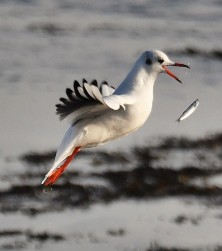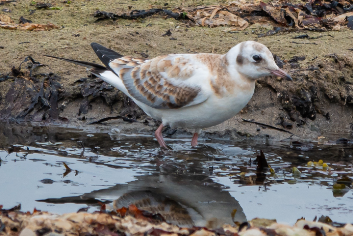Black-headed Gull on Arran
Reports


The Black-headed Gull, one of the most widespread gulls in the British Isles, does not breed on Arran. However, it is regularly recorded on the island particularly in the late summer and early autumn when birds are dispersing after breeding. These dispersing birds include young birds as well as adults.
In flight, the white leading edge to the wing is a good identifying feature. The summer adult has a chocolate-brown head (not black, although it does look black from a distance), pale grey body, black tips to the primary wing feathers, and red bill and legs. The dark head is lost in winter, leaving just two dark spots. Immature birds have a mottled pattern of brown spots over most of the body, and a black band on the tail. There is no difference in plumage between the sexes. The photos illustrate some of these features.
It breeds inland as well as on the coast, in colonies in large reed beds or marshes, or on islands in lakes, nesting on the ground. Like most gulls, it is highly gregarious in winter, both when feeding or in evening roosts. It is not a pelagic species and is rarely seen at sea far from coasts.
The black-headed gull is a bold and opportunistic feeder. It eats insects, fish, seeds, worms, scraps, and carrion in towns, or invertebrates in ploughed fields with equal relish. It is a noisy species, especially in colonies, with a familiar "kree-ar" call. Its scientific name means laughing gull.
Look out for them this autumn.

